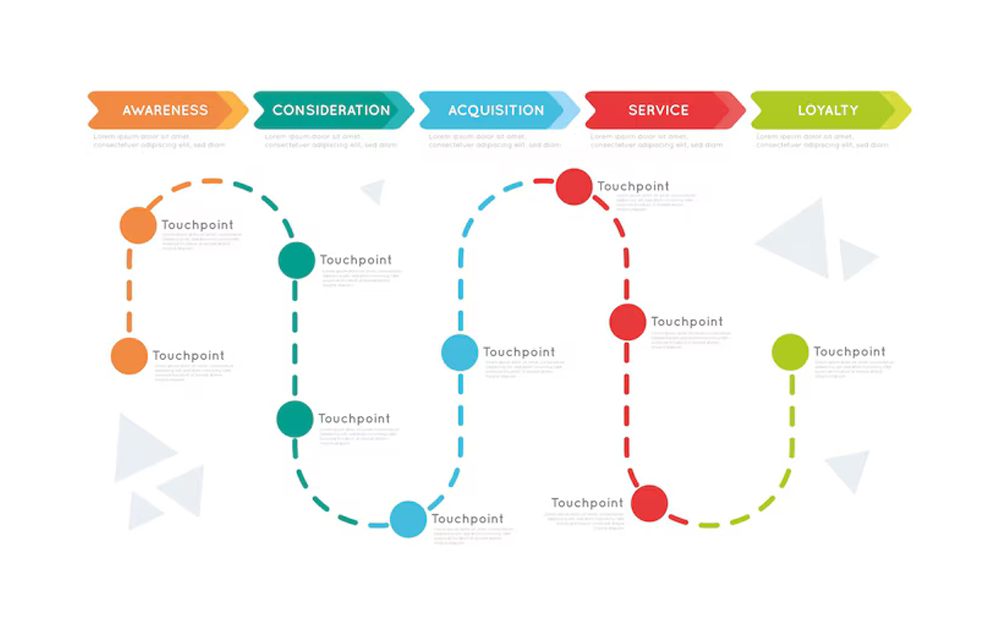Introduction
Understanding the customer journey in the present market is more critical than ever. The customer journey encompasses every interaction a customer has with a brand, from initial awareness to post-purchase experiences. It’s a complex, multi-touchpoint process that shapes how customers perceive and engage with a company.
The purpose of this blog is to delve into why the customer journey matters. We’ll explore how effectively managing the customer journey can significantly impact customer satisfaction, loyalty, and overall business success. By understanding the nuances of the customer journey, businesses can better tailor their strategies to meet evolving consumer expectations and drive meaningful engagement. Join us as we uncover the reasons why the customer journey should be at the forefront of your business strategy and how it can be leveraged to achieve greater success.
Understanding the Customer Journey
Definition and Components
- What is the Customer Journey?
The customer journey refers to the complete experience a customer goes through from the initial interaction with a brand until the post-purchase phase. It encompasses every touchpoint and interaction a customer has with a company, including both online and offline experiences.
- Stages of the Customer Journey
The customer journey is typically divided into several stages, each representing a different phase of the customer’s interaction with the brand:
- Awareness: The stage where potential customers first become aware of the brand, often through marketing efforts or word-of-mouth.
- Consideration: Customers start researching and comparing options. They seek more information and evaluate whether the brand’s products or services meet their needs.
- Decision: The point where customers decide to make a purchase or take a specific action. This stage is heavily influenced by factors such as pricing, promotions, and overall customer experience.
- Retention: After the purchase, the focus shifts to maintaining customer satisfaction, encouraging repeat purchases, and building loyalty.
- Advocacy: Loyal customers become advocates who recommend the brand to others and share positive experiences, potentially influencing new customers.
Importance of Mapping the Customer Journey
- Visualizing Customer Interactions
Mapping the customer journey involves creating a visual representation of each stage and touchpoint a customer encounters. This map helps businesses understand how customers interact with their brand at different stages and through various channels.
- Identifying Pain Points and Opportunities
By analyzing the customer journey map, businesses can identify areas where customers experience difficulties or frustrations. This insight allows companies to address these pain points and improve the overall experience. Conversely, it also highlights opportunities to enhance positive interactions and exceed customer expectations.
- Enhancing Customer Experience
A well-mapped customer journey helps businesses tailor their strategies to meet customer needs more effectively. Understanding each stage allows for more personalized interactions and targeted marketing efforts, leading to a more seamless and satisfying customer experience.
Strategies for Optimizing the Customer Journey
Mapping and Analysis
- Create Detailed Customer Journey Maps
Start by developing detailed customer journey maps that outline each stage of the customer experience, from initial awareness to post-purchase interactions. These maps should include all touchpoints, channels, and customer emotions at each stage. Tools like Microsoft Visio, Lucidchart, or specialized customer journey mapping software like Smaply can help visualize these journeys.
- Identify Key Touchpoints and Pain Points
Analyze the journey maps to identify critical touchpoints where interactions occur and potential pain points where customers might experience frustration or difficulties.
- Gather Customer Feedback
Use surveys, interviews, and feedback forms to gather insights directly from customers about their experiences at various stages of the journey. This direct feedback helps validate the journey map and highlights areas for improvement. Tools like SurveyMonkey or Google Forms can facilitate the collection of this data.
Personalization
- Segment Your Audience
Segment customers based on demographics, behavior, and preferences to tailor experiences more effectively.
- Utilize Data for Personalized Interactions
Leverage data from customer interactions, browsing behavior, and purchase history to deliver personalized content and offers.
- Implement Dynamic Content
Use dynamic content on your website, emails, and other communication channels to provide personalized experiences.
Technology and Tools
- Adopt CRM Systems
Customer Relationship Management (CRM) systems like Salesforce, HubSpot, or Zoho CRM help centralize customer data and interactions, providing a comprehensive view of the customer journey. These systems enable businesses to track and manage customer relationships, streamline communication, and automate processes.
- Leverage Marketing Automation
Marketing automation tools like Marketo or Mailchimp can help automate and personalize customer communications based on their journey stage. Automated email sequences, retargeting ads, and personalized content delivery enhance the customer experience by delivering timely and relevant information.
- Use Analytics and Tracking Tools
Implement analytics tools such as Google Analytics, Hotjar, or Crazy Egg to track customer behavior, monitor website interactions, and gather insights into how customers navigate through the journey. Heatmaps, session recordings, and conversion tracking provide valuable data for optimizing the customer journey.
Enhancing Customer Support
- Provide Multichannel Support
Ensure that customers can reach support through multiple channels such as live chat, email, phone, and social media. Offering multichannel support enhances accessibility and convenience for customers. Tools like Zendesk or Freshdesk can help manage and integrate support across different channels.
- Implement Self-Service Options
Develop self-service options such as FAQs, knowledge bases, and chatbots to empower customers to find answers and resolve issues independently. Self-service tools reduce the need for direct support and provide customers with immediate assistance. Chatbot platforms like Intercom or Drift can enhance self-service capabilities.
- Offer Personalized Support
Use CRM data to provide personalized support by referencing past interactions and purchase history. Personalized support demonstrates a deeper understanding of the customer’s needs and builds stronger relationships. Training support teams to use customer data effectively can improve the quality of interactions.
Continuous Improvement
- Monitor and Analyze Performance Metrics
Regularly track key performance indicators (KPIs) such as customer satisfaction scores, Net Promoter Score (NPS), and customer retention rates to assess the effectiveness of customer journey optimization efforts. Analyzing these metrics helps identify areas for improvement and measure the impact of changes.
- Conduct Regular Reviews and Updates
Continuously review and update the customer journey map to reflect changes in customer behavior, market trends, and business processes. Regular updates ensure that the journey remains relevant and aligned with customer expectations.
- Implement A/B Testing
Use A/B testing to experiment with different approaches and identify what works best for optimizing the customer journey.

Customer Journey Analytics
- Analyze Customer Behavior and Trends
Utilize advanced analytics to understand customer behavior and identify trends across different stages of the journey. Behavioral analytics tools help uncover patterns and preferences that inform strategy and decision-making.
- Predictive Analytics for Proactive Improvements
Leverage predictive analytics to anticipate future customer needs and behaviors. Predictive models can help identify potential issues before they arise and enable businesses to proactively address them.
Also Read: The Power of Customer and Competitor Intelligence: A Strategic Overview
Conclusion
Customer journey has emerged as a critical factor in determining business success. Understanding and optimizing this journey—from the initial point of contact through to post-purchase interactions—can profoundly impact customer satisfaction, loyalty, and overall business growth.
Through detailed mapping and analysis, businesses can identify key touchpoints and pain points, ensuring a smoother and more enjoyable customer experience. Personalization plays a crucial role in meeting individual needs and preferences, while technology and tools can streamline processes and enhance interactions. Effective customer support, including multichannel access and self-service options, further strengthens the customer experience, making it easier for customers to engage with and advocate for your brand.





